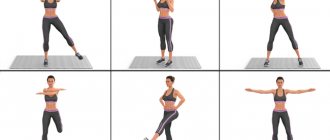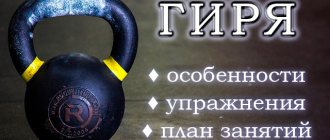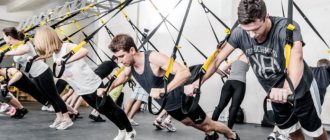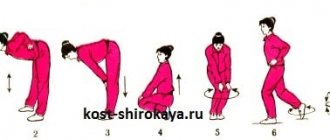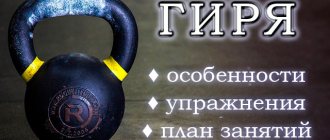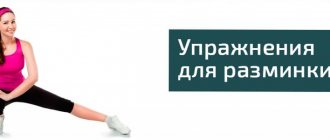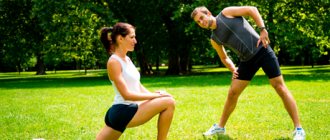A pre-workout warm-up is a set of exercises to prepare your body for physical activity, which will help you avoid injury and perform the workout as efficiently as possible. The main purpose of warming up is to gradually increase body temperature and warm up muscles that are in a state of inactivity.
We offer you a selection of warm-up exercises and a ready-made sequential plan for performing them. These exercises are equally suitable for warming up at home, at the stadium or in the gym.
Why do you need a warm-up before training?
Warming up before training is the most important part of a fitness routine. A good warm-up will gradually increase your heart rate, increase blood circulation to your muscles, tendons and ligaments, and prepare you mentally for the workout. Regardless of whether you are going to do strength training or cardio exercises, it is necessary to warm up before training.
Benefits of warming up before training:
- You warm up your muscles, ligaments and tendons, this improves their elasticity and reduces the risk of injuries and sprains.
- Warming up before training will help stretch the joints that receive a lot of stress during training. Your joints are at risk of injury if you don't do preparatory exercises.
- Warm muscles contract and relax better during exercise, which means your strength capabilities during exercise will be higher.
- Warm-up exercises optimize the activity of the cardiovascular system: this will help reduce the load on the heart during exercise.
- Warming up before exercise improves blood circulation, which will saturate your muscles with oxygen and nutrients. This will help increase your endurance during exercise.
- During a warm-up, your body increases the production of hormones responsible for energy production.
- Training is a kind of stress for the body, so a high-quality warm-up will prepare you for stress from a mental point of view, improve coordination and attention.
- During light warm-up exercises before training, adrenaline is released into the blood, making your body better able to cope with physical activity.
A good warm-up before training will help you not only avoid injuries and problems with the cardiovascular system, but also make your workout more effective. If you want to skip the warm-up and save time so you can focus more on increased loads for quick results, then this is the wrong way. After warming up, your body will work better, you will be more energetic and resilient, which will give you much better results in the long run.
A dynamic warm-up should be carried out before any workout, regardless of the type of load: strength training with weights, running, cardio training, cycling, kickboxing, dance training, split stretching, crossfit and any other sports direction. Warming up before training is necessary both when exercising in the gym and at home (outside).
Why don't people warm up before working out?
Many people don't warm up before exercise, considering it a waste of time. You've probably heard more than once from friends or acquaintances: “I regularly do strength and cardio training in the gym and never warm up or cool down. I didn’t feel any harm.” Never rely on someone else's dubious experience!
Firstly, each person has his own individual level of strength; no one knows the reserves of his body. It may not fail for a month, two, a year or even a couple of years, gradually wearing out, but how long this can last is unknown. Secondly, in conditions of excessive and very often contradictory information on fitness, many of us already make a lot of mistakes that can affect our health. Therefore, try to follow at least the canonical recommendations - doing a warm-up before each workout is one of them.
It's important to note that even personal trainers and group exercise trainers may not devote a minimum amount of time to warming up. But you yourself are responsible for your health, so don’t be lazy to come 10 minutes before training and do the warm-up yourself. Even if you haven’t had any injuries to date, remember that a cold tendon tear or other unpleasant injury can happen at any time.
The situation is similar with home workouts, of which a large number are now being produced. Typically, programs are designed for 20-30 minutes, which is very important for many people in busy conditions. And of course, in such short programs, at best, 2-3 minutes will be devoted to warm-up, and at worst, there will be no warm-up at all.
What are the dangers of not warming up?
Research shows that only 5% of people do a good warm-up before exercise, and this is a very sad statistic. Many exercisers believe that this is a waste of time, which is already limited in fitness classes. Let's remember once again why not warming up before training can be dangerous, in addition to reducing the effectiveness of the activity?
- The most common problem that occurs when you don't warm up before exercise is a sprained ligament. A very unpleasant and painful syndrome, due to which you will have to take a break from training.
- An even more unpleasant problem is joint injury. If you exercise on a cold joint, there is a high risk of damaging it. The danger of a joint injury lies not only in the duration of recovery, but also in the fact that after the injury it will constantly remind itself. Due to improper loads, the joints of the knees, ankles, shoulder and hip joints are especially often affected.
- Without a good warm-up, dizziness or even fainting may occur due to the high load on the heart.
- A sudden sharp load without a preparatory warm-up can cause a sharp jump in pressure, which is equally dangerous for people with hypertension and hypotension.
Pre-workout warm-up structure
It is advisable to warm up before training for at least 7-10 minutes. It is better to start warming up by walking in place to warm up the body. Then you should perform joint exercises and dynamic exercises to stretch the muscles. The warm-up ends with moderate-intensity cardio exercises. At the end of the warm-up, we restore our breathing by taking a deep breath and exhaling.
Warm-up structure before training for 7-10 minutes:
- Walking in place: 1 minute
- Joint gymnastics: 2-3 minutes
- Dynamic muscle stretching: 2-3 minutes
- Cardio warm-up: 2-3 minutes
- Recovery breathing: 0.5-1 minute
Joint exercises activate the work of joints, tendons and ligaments, improve their mobility and help work out the periarticular muscles. Dynamic stretching will make your muscles more elastic, which will help them perform at their best throughout your workout. Cardio warm-up will increase your body temperature, increase blood circulation, and prepare your muscles for further stretching.
Thanks to this warm-up, you will make your heart work faster, speed up blood circulation, and gently awaken all the muscles of the body. After a proper warm-up, a pleasant warmth spreads throughout your body, you feel invigorated and full of energy. If you plan to do stretching or splits as a workout, then the final cardio warm-up can be increased to 5-7 minutes.
Do not confuse warming up before training with stretching after training. In the warm-up, your goal is to warm up the muscles and joints, increase blood circulation, and prepare the body for stress. Warm-up should not be slow and static, you should warm up well. After training, on the contrary, you should restore your breathing, lower your heart rate and perform static stretching exercises.
Stretching for individual muscle groups:
- 10 Quadriceps Stretch Exercises
- 10 exercises to stretch your buttocks
- 10 exercises to relax your legs
- 16 Exercises to Stretch Your Arms and Shoulders
- 10 exercises to stretch your pectoral muscles
What is a warm-up and why is it needed?
Warm-up is a set of exercises aimed at preparing the body for the workout itself. These are exercises for warming up muscles, preparing joints and ligaments for the upcoming load. And although many athletes neglect warming up, its absence can be fraught with the following troubles:
- sprain. The most common and painful option, which will entail a break in training for some time.
- joint injury. The most commonly affected joints are the knee, hip, ankle, and shoulder joints. The danger of damaging unprepared joints is unpleasant not only because of the long recovery period, but also because the damaged joint will continue to periodically remind itself.
- a sharp rise in pressure. With a high load on the heart muscle and blood vessels, which any workout causes, if you do not sleep on it, of course, a sharp increase in pressure is possible. This must be remembered especially for those who are already experiencing problems with high or low blood pressure.
The positive effects of warming up before exercise:
- prepares all body systems for upcoming stress,
- improves blood supply, helping to saturate muscles with oxygen, dilates blood vessels, gradually increases pulse,
- tones and increases the elasticity of muscles, ligaments,
- promotes better joint mobility,
- reduces the risk of injury during strength or weight training,
- accelerates the transmission of nerve impulses,
- promotes concentration on the workout itself, especially when it is important to switch after a hard day at work.
Warm-up usually takes 7-10-15 minutes. Don’t be too lazy to spend it on preparing for training, your body will respond gratefully to this, and the training itself will be more efficient and effective.
Warm-up exercises
The importance of warming up is difficult to overestimate; it is a fundamental part of training. First, a good warm-up before exercise reduces the risk of injury. Secondly, warmed muscles work more efficiently. Warm-up should include a complete and well-thought-out set of exercises that will help prepare your body for training.
Stage 1: Walking in Place
It is better to start your warm-up by walking in place to warm up your body a little and avoid pulling muscles during dynamic stretching. As you walk, your heart rate should rise slightly and your body temperature should increase. Perform two exercises for about 30 seconds each.
1. Walking with knees up
We begin our warm-up by walking in place. Raise your knees up, synchronously moving your arms along your body. Don't push yourself too hard, start warming up at a gentle, calm pace.
How much to do: 18-20 knee raises in total.
2. Raising hands and knees
And one more gentle warm-up exercise. Continue raising your knees, but now include your arms. Raise your arms above your head and lower them down, bending your elbows.
How much to do: 18-20 knee raises in total.
Stage 2: Joint gymnastics
Joint exercises are a necessary part of the pre-workout warm-up if you don’t want to get joint problems in the future. Joint gymnastics is usually performed from top to bottom, starting from the neck and ending with the feet, but the order of the exercises does not play a fundamental role. Remember to perform rotational exercises both clockwise and counterclockwise.
Joint exercises will be useful, by the way, as a regular morning exercise.
1. Head tilts
We start warming up before training with the neck. Turn your head to the right, forward, left, forward, trying not to make sudden movements. Don't throw your head back.
How much to do: 14-16 inclinations in total.
2. Shoulder rotation
Lower your arms along your body and begin to rotate your shoulders in a circle. Gradually increase the amplitude, trying to stretch your shoulder joints well.
How much to do: 5 rotations in one direction, then 5 rotations in the other direction.
3. Elbow rotation
Before training, be sure to stretch your elbow joints, which receive a lot of stress during upper body training. To do this, raise your arms parallel to the floor and perform rotational movements with your forearms.
How much to do: 5 rotations in one direction, then 5 rotations in the other direction.
4. Arm rotation
We continue the warm-up before training with arm rotations. Raise your arms above your head and begin to rotate them, stretching your shoulder joints well. Move your arms widely and amplitude, the rotations should not be sluggish.
How much to perform: 5 forward rotations, then 5 backward rotations.
5. Wrist rotation
If you are training your arms or doing planks and push-ups, be sure to give your wrist joints, which receive a lot of stress, a good stretch before training. To do this, bend your elbows and begin to rotate your wrists in a circle.
How much to do: 7 rotations in one direction, then 7 rotations in the other direction.
6. Pelvic rotation
Place your hands on your waist and spread your legs wider than shoulder-width apart. Start rotating your pelvis in a circle, as if you were trying to draw a circle with your buttocks. The feet do not come off the floor, rotation occurs due to the movements of the pelvis, not the body.
How much to do: 5 rotations in one direction, then 5 rotations in the other direction.
7. Leg rotation
Hands remain on your waist, place your feet closer to each other. Lift one leg off the floor and begin to rotate it in a circle, stretching the hip joint. The knee seems to be making a circle, the torso remains stable.
How much to perform: 10 total rotations on both legs, first forward, then 10 total rotations on both legs backwards.
8. Knee rotation
Tilt your body, bend your knees slightly and place your palms on them. Start rotating your knees, keeping your heels on the floor. This is an excellent exercise for warming up the knee joints, which receive a lot of stress during training.
How much to do: 7 rotations in one direction, then 7 rotations in the other direction.
9. Foot rotation
Stand up straight, place your hands on your waist. Lift your knee up. Start rotating your foot, stretching the ankle joint well. Try to rotate only your foot, keeping your shin and thigh still.
How much to do: 5 rotations in one direction and 5 rotations in the other direction on one leg, then the same on the other leg.
Stage 3: Dynamic Muscle Stretching
After joint gymnastics there is a stage for dynamic stretching of different muscle groups. Here are more vigorous pre-workout warm-up exercises that will prepare your body for the challenge.
1. Arm raises for shoulders, back and chest
Stand straight with your feet shoulder-width apart. Arms are spread out to the sides and parallel to the floor. Then cross your arms, bringing them together at your chest. As you do this pre-workout warm-up exercise, feel a pleasant stretch in your back between your shoulder blades.
How many to perform: 8-10 repetitions
2. Elbow extensions for deltoids and shoulder joints
Stay standing straight, bend your elbows at right angles and raise them parallel to the floor. Bring your hands together. Then spread your arms wide to the sides without dropping your elbows. Feel the work of the shoulder joints and the tension in the deltoids (shoulder muscles) and triceps (muscles of the back of the arms).
How many to perform: 8-10 repetitions.
3. Curls for biceps and triceps
This is a very simple pre-workout warm-up exercise that will help you stretch your arm muscles - biceps and triceps. To do this, move your straight arms back a little and begin to bend and straighten your arms to maximum amplitude.
How many to perform: 8-10 repetitions
4. Abdominal and oblique twists
Stand straight, spread your legs wide. Stretch your arms out to the sides until they are parallel to the floor. Begin to alternately turn your body to the right and left. The rotation should be accomplished by twisting the body, not rotating the pelvis. This exercise is very useful for warming up the abdominal muscles.
How much to perform: 8-10 turns in total.
5. Side Bends for Abs and Obliques
And another effective exercise for the abs and oblique muscles. Place your hands on your waist and begin to alternately bend to the right and left, stretching behind your outstretched arm. This exercise is also useful for relieving tension from the back and straightening the spine.
How much to do: 8-10 inclinations in total.
6. Bending for the back and spine
This is a very simple and extremely effective exercise not only for warming up before training, but also for relaxing the spine. It can be performed if you feel tension and stiffness in your back. Sit in a shallow half-squat, place your palms on your hips, and have a slight arch in your back. Round your spine at the thoracic region as you rise slightly from the squat. Then arch your back again.
How much to perform: 6-8 repetitions.
7. Squat Bend for Back and Shoulders
Lower yourself into a deep sumo squat, with your back slightly tilted and your palms on your knees. Start bending first to one leg, then to the other. Do this exercise to warm up before your dynamic workout.
How much to perform: 6-8 turns in total.
8. Tilts to the floor with a turn
Stand up straight, spread your arms to the sides, place your feet wide. Start bending towards the floor, turning your body and trying to touch the floor first with one hand, then with the other. Keep your back straight, do not strain your neck, and move your shoulders away from your ears.
How much to do: 8-10 inclinations in total.
9. Squats with arm raises
Spread your legs wide and raise your arms above your head. Lower your pelvis down, squatting until your thighs are parallel to the floor. The arms move synchronously, going down along with the squat. During the squat, do not bring your knees forward of your toes and do not lift your heels off the floor.
How many to perform: 8-10 repetitions.
If you want to make this exercise easier to warm up before training or you are not planning heavy training, you can do half squats:
10. Lateral lunges to warm up the legs
Spread your legs wide, arms folded near your chest. Start squatting, transferring your body weight to your right leg until it is parallel to the floor. dropping into a side lunge. The left leg remains fully extended. Then straighten up and lunge onto your left leg. Perform side lunge rolls to properly warm up your legs before training.
How much to do: 8-10 lunges in total.
11. Lunges to warm up your legs
Stand straight with your feet slightly narrower than your shoulders. Begin lunging backwards while raising your arms above your head. It is not necessary to lower your knees to a right angle; in the warm-up before training, an incomplete range of exercises is acceptable. If you have difficulty maintaining your balance, you can put your hands on your waist or hold on to a wall or chair.
How much to do: 8-10 lunges in total.
If you want to make this exercise easier or you don’t plan on doing heavy training, you can do half lunges.
12. Tilts towards the foot for the back of the thigh
Stand up straight, place your right hand on your waist, and raise your left hand above your head. Place your right leg half a meter forward, resting on your heel, and straighten it completely. Then bend down towards your right leg with your back straight, touching your right toe with your left hand. The left leg bends at the knee. Feel the stretch in your hamstrings, hamstrings, and calves.
How much to do: 5-6 bends, first on one leg, then the same amount on the other.
13. Tightening the knees to stretch the buttocks
Stand up straight, bend your arms and keep them near you. Lift the knee of one leg up and pull it towards your chest with your hands. Feel the stretch in your gluteal muscles. Then return to the starting position and pull your other leg towards you.
How much to do: 8-10 knee pull-ups in total.
14. Foot Pulls to Stretch the Quadriceps
Stand up straight, lower your arms along your body. Bend your leg and pull your foot toward your buttocks with your hand. Hold for a second, stretching your quadriceps (front thigh). Then return to the starting position and pull the foot of the other leg towards the buttocks.
How much to do: 8-10 foot pull-ups in total.
Stage 4: Cardio Warm Up
In the final phase of the warm-up, we'll do a couple of cardio exercises to further warm up and raise our body temperature. The speed and intensity of the exercise can be increased or decreased, the duration of the final cardio warm-up is 2-3 minutes. The speed and pace of the exercises depends on your capabilities.
1. Running in place with shin overlapping
Stand straight, bend your elbows, palms facing forward. Start running in place, raising your legs high, your arms moving freely along your body. Loop your legs as if you were trying to hit your buttocks with your heels.
How much to do: 25-30 laps in total.
If running is contraindicated for you, then walk in place at a fast pace, raising your knees high (exercise #1 in the first stage).
2. Jumping rope
Stand up straight, bend your arms at the elbow and spread them to the side - as if you were holding a jump rope in your hands. Start making light and soft jumps in place, imitating jumping rope. There is no need to jump too intensely; after all, this is a warm-up before training, and not the training itself.
How many to perform: 25-30 jumps.
If jumping is contraindicated for you, then continue to walk in place at a fast pace, raising your knees high. Engage your arms by moving them up and down (exercise #2 in the first stage).
3. Jumping with arms and legs raised
Remain standing straight with your feet together. While jumping, spread your legs wide and bring your arms above your head. Keep your knees slightly bent. Land softly on your toes to reduce stress on your joints. Breathe to the rhythm of your jumps. These jumps are called Jumping Jacks, and they are great for both warming up and any cardio workout.
If jumping is contraindicated for you, then instead of jumping, alternately move one leg to the side, then the other. Hands move synchronously.
How many to perform: 20-25 jumps.
Stage 5: Restoring breathing
Be sure to remember to restore your breathing after performing cardio exercises by taking a deep breath in and out for 30-60 seconds. Choose one of the exercises below or do both.
1. Restoring breathing with a tilt
Raise your arms straight above your head and take a deep breath. As you exhale, tilt your body and arms, exhaling deeply and fully. Feel your heart rate decrease and your rapid breathing calm down.
How much to do: 8-10 bends.
2. Restoring breathing with squats
This exercise is best suited for those who feel dizzy when tilting their head to the floor as in the previous exercise. Sit down with your arms crossed at your chest and take a deep breath. As you exhale deeply, straighten up completely and raise your arms above your head.
How much to do: 8-10 bends.
Stage 6: Special warm-up
If you perform strength training with heavy weights, then be sure to also pay attention to a special warm-up. It is aimed at maximum warming up of those muscles that will actively participate in the training. As part of a special warm-up, you should perform exercises from the main complex, but without weights or with light weight (20-30% of the maximum).
Let's give an example of a special warm-up. Let's say you plan to do squats with a barbell weighing 80 kg. This means that before this exercise you should do a warm-up set of 10-15 repetitions with an empty bar or with a bar weight of 20-30% of the maximum weight.
A special warm-up should be performed immediately before an exercise or before training an entire muscle group. Attention, a special warm-up does not replace a general warm-up before training! This is only one of the stages of the lesson, but also very important.
We emphasize once again that a special warm-up is performed after the general one, and not instead of it.
How to warm up before running or doing cardio?
How to properly warm up before running or other cardio exercise? In this case, proceed according to an absolutely similar scheme: a small cardio warm-up for 2 minutes (running in place, light jumping rope) and then joint gymnastics + stretching. And only after that, proceed directly to cardio training, gradually increasing the intensity.
Many people think that it is not necessary to warm up before a cardio workout. However, this is not true. Muscles, joints, and heart receive serious stress while running and jumping, so it is very dangerous to exercise without warming up. Just walking and gradually increasing intensity without doing warm-up exercises for joints and muscles is not enough! Be sure to do joint exercises and stretching before cardio training.
Check out our other selections of warm-up exercises:
- Ready-made warm-up and cool-down for arm and shoulder training
- Ready-made warm-up and cool-down for back and biceps training
- Ready-made warm-up and cool-down for chest and triceps training
- Ready-made warm-up and cool-down for abdominal and back training
- Ready-made warm-up and cool-down for leg training
- Ready-made warm-up and cool-down for running or cardio
- Universal warm-up for the whole body for 5 minutes
- Universal warm-up for the whole body for 10 minutes
Features of warming up before training:
- We warm up from top to bottom (neck, shoulders, arms, chest, back, core, legs). But this is rather a traditional approach to warm-up exercises; the order of the exercises does not play a fundamental role.
- Warm-up should take place at a dynamic but gentle pace. Your goal is a gentle warm-up and preparation for more intense exercise. You should feel warm throughout your body from the warm-up, but don't overdo it.
- You should start warming up with a slow pace and small amplitude of movements, gradually increasing the pace and amplitude.
- Avoid long static positions; warm-up before training should include dynamic exercises. Do not confuse this with post-workout stretching, which involves freezing in one position for 30-60 seconds to stretch the muscles.
- When warming up before training at home or in the gym, avoid sudden movements and try to perform the exercises smoothly. You should not allow pain or discomfort in the joints (crunching in the joints may be, this is not scary).
- If you work out in a cool room (or outdoors), then dress warmly to warm up faster or increase the warm-up to 15-20 minutes.
- If you know that you will train some part of your body particularly intensely today, then pay special attention to it during your warm-up. For example, on a lower body workout day, thoroughly stretch your hips and knees, and stretch the muscles in your legs and buttocks.
- If you work out at the gym, you can use a treadmill or elliptical trainer as a cardio warm-up. Always start at a slow pace and let your heart rate rise gradually.
Wherever you exercise: at home, on the street or in the gym, be sure to warm up before training, and then physical activity will bring you pleasure, benefit and results.
See also:
- Universal warm-up before training for 5-10 minutes
- Joint warm-up for 5 minutes: before training and for exercise
- Exercises for weight loss while standing: 20 exercises without jumping
- Exercises for older people: 10 simple exercises

